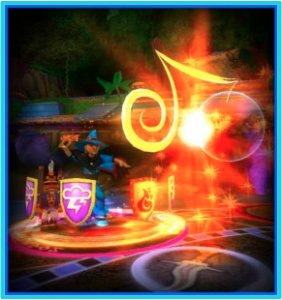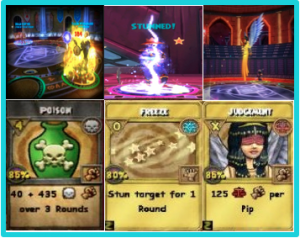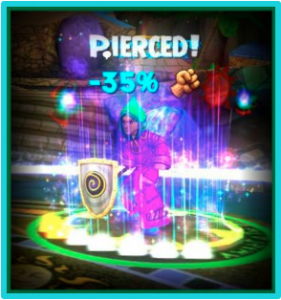April 2, 2015 October 9, 2018
Pressure and Kill Options
Pressure is one of those terms that I use a lot in my articles, sometimes even with little explanations about what it is and how to use it. While these are great, I am here to provide a more in-depth explanation of what exactly pressure is and what its goal is. Let’s start with definitions:
Pressure
(n) the use of offense or offensive potential to make an opponent play more fearfully
And now, a related concept to pressure:
Kill Option
(n) a method to kill an opponent (generally referencing a string of moves leading to and including the final blow rather than the final blow itself)
Now, let’s talk about how and why we use pressure.
The Power of Pressure
 Pressure is an essential part of PvP because it limits your opponent’s breathing room; in other words, they don’t have as many options while under pressure. This can be for multiple reasons, some being because you are literally dealing damage, because you have to potential to deal devastating amounts of damage, because you can ignore all of their defenses, etc., any of which will force them to play more defensively. Applying pressure is what makes your opponent think twice before setting up to kill you. In this way, utilizing pressure can often be the difference between a win or a loss.
Pressure is an essential part of PvP because it limits your opponent’s breathing room; in other words, they don’t have as many options while under pressure. This can be for multiple reasons, some being because you are literally dealing damage, because you have to potential to deal devastating amounts of damage, because you can ignore all of their defenses, etc., any of which will force them to play more defensively. Applying pressure is what makes your opponent think twice before setting up to kill you. In this way, utilizing pressure can often be the difference between a win or a loss.
Pressure is all about being an offensive threat. To use it effectively, you need to either make them feel or show them that they are not safe. This is done with two major types of pressure, which I will explain more later: dealing significant damage, or being in a very flexible position. Both are important in different ways. A general rule of thumb when applying pressure is to not waste too many pips. This is because if you do, your position isn’t threatening anymore and your opponent will be able to heal off your damage. You always want to stay flexible when applying pressure. It is important to note that applying pressure is not the same as playing offensively. Applying pressure is generally part of the neutral stance; i.e., you aren’t trying to seriously damage your opponent, and you want to stay flexible. Playing offensively means you are trying to seriously damage your opponent and you are utilizing more resources to ensure that they don’t recover. Applying pressure can create an opening to strike if they don’t respond by defending properly, but the two are not the same.
pressure is generally part of the neutral stance; i.e., you aren’t trying to seriously damage your opponent, and you want to stay flexible. Playing offensively means you are trying to seriously damage your opponent and you are utilizing more resources to ensure that they don’t recover. Applying pressure can create an opening to strike if they don’t respond by defending properly, but the two are not the same.
Now, let me return to a concept I introduced earlier: literal pressure vs. potential pressure. I feel like a helpful way to explain these is through the use of simple physics. When talking about energy, there are two major types: kinetic (active) energy and potential (stored) energy. If an object is off the ground and not moving, for example on a roller coaster at the top of a hill, it has lots of (gravitational) potential energy but no kinetic energy. As it gets to the ground, the roller coaster moves faster. Its potential energy turns into kinetic energy. Similarly, potential pressure is “stored” damage (in the form of pips), while literal pressure is damage being applied (using pips). Feel free to take a closer look at each type below.
So now that you know all about pressure, you’re probably wondering how putting your opponent under pressure will help you win the match. This is where my next topic comes in.
Utilizing Kill Options
 A kill option is a path to get from any point in the match to your opponent’s head wobbling. The more you have, the better, because your opponent will be less likely to shut down all of them. It is important to formulate an offensive plan so your moves aren’t disconnected and easier to counter. A kill option can be something vague such as establishing your minion, wait for it to Link/Elf, then Heckhound, something short and specific such as a Storm Lord to Triton combo, or something long and more elaborate such as Deathblade to Doom to Infallible to Poison to Stun to Judgement. The point of a kill option is to have SOME sort of plan, and to not use random cards that may be useful for getting the kill in their own way but aren’t efficient when put together. It is important to note that efficiency is key with kill options; if you aren’t quick or effective enough, it could lose you the match.
A kill option is a path to get from any point in the match to your opponent’s head wobbling. The more you have, the better, because your opponent will be less likely to shut down all of them. It is important to formulate an offensive plan so your moves aren’t disconnected and easier to counter. A kill option can be something vague such as establishing your minion, wait for it to Link/Elf, then Heckhound, something short and specific such as a Storm Lord to Triton combo, or something long and more elaborate such as Deathblade to Doom to Infallible to Poison to Stun to Judgement. The point of a kill option is to have SOME sort of plan, and to not use random cards that may be useful for getting the kill in their own way but aren’t efficient when put together. It is important to note that efficiency is key with kill options; if you aren’t quick or effective enough, it could lose you the match.
When you’re starting out, it is perfectly ok (and encouraged) to have an idea of what you’re going to do before you get into the match. Think of a few ways in which you can get the kill. One example would be to wait until you have close to max pips and have a buff, and go for a Poison to Stun to Judgement (on a mid-level Death wizard with Balance amulet). Don’t be afraid to get creative with these combos. Keep in mind  that DoTs are good tools for shield breaking, and stuns/stunning attacks are good for combos. Healing suppression can also be critical, so don’t forget Doom and Gloom or Infection when executing a kill option. Utilities such as minions can also be great to use, be them for breaking shields or baiting your opponent into killing it and buying you a free round. Lastly, shields and defense can also be a necessary part of a kill option (although it may seem counter-productive). A well timed shield in an attack sequence can help you execute it much more easily.
that DoTs are good tools for shield breaking, and stuns/stunning attacks are good for combos. Healing suppression can also be critical, so don’t forget Doom and Gloom or Infection when executing a kill option. Utilities such as minions can also be great to use, be them for breaking shields or baiting your opponent into killing it and buying you a free round. Lastly, shields and defense can also be a necessary part of a kill option (although it may seem counter-productive). A well timed shield in an attack sequence can help you execute it much more easily.
Although it is great to have thought of your kill options before a match, with experience you should be able to adapt to your in-match situation and work up a kill option on the fly. This is where knowing your deck and discarding play a huge role. Knowing the most efficient kill option to counter a specific situation can vary. Two major ones that come into my mind display two different types of adaption: post-adaption and pre-adaption. Post-adaption is adapting to a play that your opponent has made to shut off a kill option  (e.g., a Stun Block will shut down most Stun based kill options). Pre-adaption is read based, requiring a prediction of an opponent’s move, knowledge of their playstyle, and a bit of luck (e.g., against an offensive opponent who doesn’t like to shield much, you may be able to cut a DoT out of your kill option). The latter type is much more efficient, but is also much more difficult to execute. Creating kill options on the fly is hard to teach, but it should come with experience.
(e.g., a Stun Block will shut down most Stun based kill options). Pre-adaption is read based, requiring a prediction of an opponent’s move, knowledge of their playstyle, and a bit of luck (e.g., against an offensive opponent who doesn’t like to shield much, you may be able to cut a DoT out of your kill option). The latter type is much more efficient, but is also much more difficult to execute. Creating kill options on the fly is hard to teach, but it should come with experience.
Now, the burning question you’re probably wondering (maybe not, who knows,) is how this all relates to pressure. There are a number of ways in which these concepts are linked, but the most apparent one is that pressure and kill options supplement each other. By this I mean that pressure helps create openings for kill options, and having available kill options helps to create pressure. Pressure and kill options feed off of each other, and using both of them effectively will greatly improve your PvP game by making your moves more synchronized with each other.
If you have any questions/comments/concerns, please comment below!
Happy Dueling!

 Literal pressure is generally best applied with low-mid pip spells, often with utilities added, and more useful at higher levels simply because it is more threatening in the offensive meta. An example of a good literal pressure tool is Storm’s Wild Bolt, because it is low on pips and deals decent damage while sometimes dealing huge damage. Remember to not get carried away and to leave yourself some pips to work with.
Literal pressure is generally best applied with low-mid pip spells, often with utilities added, and more useful at higher levels simply because it is more threatening in the offensive meta. An example of a good literal pressure tool is Storm’s Wild Bolt, because it is low on pips and deals decent damage while sometimes dealing huge damage. Remember to not get carried away and to leave yourself some pips to work with.
 Potential pressure is most effective when you have lots of pips and buffs. Applying potential pressuremeans being able to deal damage, and keeping your opponent aware of it. It is key to build pips to use this type of pressure as well as to use your blades. It is often better to use this type of pressure at lower levels because at high level, the offensive meta renders building pips and buffs in general less effective.
Potential pressure is most effective when you have lots of pips and buffs. Applying potential pressuremeans being able to deal damage, and keeping your opponent aware of it. It is key to build pips to use this type of pressure as well as to use your blades. It is often better to use this type of pressure at lower levels because at high level, the offensive meta renders building pips and buffs in general less effective.